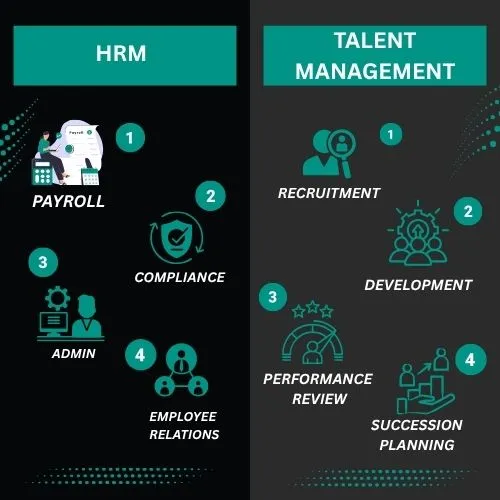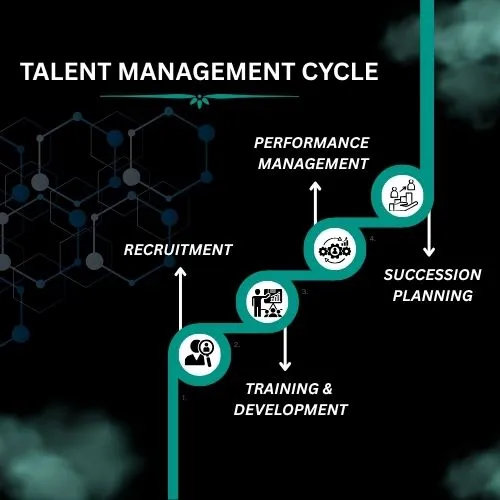Businesses—whether small, mid-sized, or multinational—consistently strive for a competitive advantage. One of the most valuable tools to achieve this edge is human resources (HR). Strategic HR empowers organisations to plan proactively for their workforce needs. Among its most vital components is talent management—a process focused on recruiting, training, developing, and retaining employees. These individuals, once nurtured properly, can become essential contributors to a company’s long-term success.
Understanding the Difference Between Talent Management and HR
Many HR managers and CEOs are enthusiastic about implementing talent management practices but often lack clarity on what it truly involves or how it differs from traditional HR.
Talent management refers to a company’s strategic approach to attracting, hiring, training, developing, and retaining employees. It encompasses several critical HR functions such as recruitment, learning and development, performance evaluation, and succession planning.
By contrast, human resource management (HRM) is a broader organisational function. It includes HR service delivery, employee relations, administrative operations, payroll, compliance, and workforce planning—with talent management as a key subset.
Having it take centre stage does not diminish the relevance of other HR functions. Instead, it introduces new strategies and methodologies to optimise workforce potential.

Key Stages
As a vital part of strategic HR, talent management comprises several core stages:
1. Hiring and Recruitment
The foundation of talent management lies in effective hiring and recruitment practices. This involves identifying and attracting individuals whose values and competencies align with the company’s culture and strategic objectives.
Strong recruitment strategies focus on:
- Reaching candidates through reliable, professional platforms
- Seeking culture-fit employees committed to long-term growth
- Highlighting the employer brand and career development opportunities
2. Training and Development
Once the right talent is brought in, training and development become essential. This stage ensures employees are well-equipped for their roles and are continuously growing.
Organisations can offer:
- Formal training sessions and development programmes
- Mentorship and coaching opportunities
- Cross-functional rotations for diverse skill-building
These efforts enhance employee confidence and prepare them to contribute meaningfully to organisational goals.
3. Performance Management
After development, it’s crucial to monitor and manage employee performance. This stage helps identify gaps, reinforce strengths, and create a culture of accountability and excellence.
Effective performance management involves:
- Defining clear performance goals and KPIs
- Conducting regular reviews and feedback sessions
- Recognising achievements and addressing performance concerns
A transparent feedback system fosters continuous improvement and motivation across teams.
4. Succession Planning
Succession planning is critical to ensuring continuity, especially in key roles. According to a Gartner survey, around 90% of talent management leaders are responsible for succession planning initiatives.
This long-term strategy includes:
- Identifying future leaders within the organisation
- Offering leadership training and development programmes
- Providing platforms for emerging leaders to demonstrate their capabilities

Succession planning not only lowers turnover risk but also builds a strong internal leadership pipeline.
Benefits of Talent Management
An effective strategy can offer numerous organisational advantages:
- Greater employee engagement and morale
- Improved workforce productivity and performance
- Reduced turnover and hiring costs
- A sustainable competitive edge in the market
When businesses proactively invest in it, they build a more agile and committed workforce ready to drive strategic success.
Best Practices for Aligning HR and Talent Management
To ensure talent management operates effectively, organisations should:
- Align HR and talent management objectives
- Encourage consistent communication between departments
- Clearly define responsibilities for each team
- Promote cross-functional collaboration and leadership development
By integrating these practices, companies can streamline operations and make both HR and talent management more impactful.
Final Thoughts
Talent management is not a replacement for human resource—it is a critical component of it. When practised effectively, it enhances HR efficiency by decentralising and distributing responsibilities.
Companies that recognise the importance of talent management and invest in it early are more likely to thrive in today’s competitive landscape.
👉 Looking to improve your talent strategy? Start by evaluating your current recruitment and development processes—small changes can lead to significant results.



